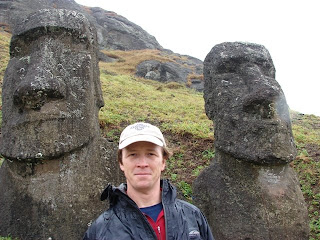 The Moai of Tongarika.
The Moai of Tongarika.The team has been working incredibly hard the past four and a half weeks. With all of our traps deployed yesterday, and our incredibly find of millipedes, we had a down day today. So, a day off was both well earned and well deserved.
 A cave near Akahanga.
A cave near Akahanga.We decided we would be tourists and see some of the sites. We had yet to venture to the northern coast of the island, and it was nothing short of spectacular. The only issue we had to contend with was the rain. However, after spending a month in the driest desert in the world, another South Pacific storm was welcomed. Most everyone, save for Dan, had Gore-tex shells. In addition, it was around 65° F today, so despite the rain, it was still rather comfortable. Back to the rain, the rain on the island continues to come down in buckets. The last time I saw rain of this magnitude was when I worked in Belize.
 The ruins of Akahanga.
The ruins of Akahanga. For more information about that expedition, you may read a paper we had published back in 2005. Wynne, J.J. and W. Pleytez (2005), Sensitive Ecological Areas and Species Inventory of Actun Chapat, Vaca Plateau, Belize. Journal of Cave and Karst Studies 67: 148-157. While this paper doesn’t describe the weather conditions per se, it was a great expedition nonetheless. My apologies for the digression…back to Rapa Nui.
 One of the toppled Moai of Akahanga.
One of the toppled Moai of Akahanga.Our first stop was Akahanga. During the years of political unrest and warfare on the island, all of the Moai were toppled. The site of Akahanga has been left just as the people of Rapa Nui left it. While we have encountered all of the impressive Moai atop the Ahu, this is a reminder of what their villages looked like when the Moai were brought down.
 Me standing before one of the many unfinished Moai at the quarry of Rano Raraku. Credit: Dan Ruby.
Me standing before one of the many unfinished Moai at the quarry of Rano Raraku. Credit: Dan Ruby.Our first major stop was a basalt quarry named Rano Raraku. We spent a couple of hours at this location. This site is located on what appears to be a large basalt dome – perhaps even the basalt plug of an old volcano. While I have observed many Moai perched impressively upon the Ahu (ceremonial platforms), when I saw the quarry Rano Raraku, I was astounded. This quarry is quite humbling. This represents a work undone. There were plans for most of these Moai to take prominent seats atop the sacred Ahu, yet these Moai never made it. The society of the Rapa Nui Moai carvers largely collapsed, and these sacred stones now festoon a verdant green hill side. While I’m providing many pictures of this site, its vastness and impressiveness cannot be captured with photos. One must go there to truly appreciate it.
 Christina at Rano Raraku.
Christina at Rano Raraku.Our next stop was Tongarika. This was a Ahu Moai site characterized by 15 Moai looking silently over the ruins of a village below them. This is the largest assemblage of Moai on Easter Island. This site is most impressive.
 A breath-taking shot near Anakena on the island's north coast.
A breath-taking shot near Anakena on the island's north coast.Our final stop was Anakena. This was also the location of a village, but it has an added attraction; it is the only place on Rapa Nui with a white sand beach. This beach is about 150 meters wide and is situated within a small cove. At the edge of the beach are seven Moai facing a thicket of palm trees with the ruins of the village slightly beyond.
It continues to rain here on Rapa Nui, and it will likely continue through our stay here. I will continue to sleep with my ocean side door open (as I have since my arrival), and allow the roar of the ocean and the falling rain to put me to sleep. Life is incredibly rich on Rapa Nui.
 Me and unfinished Moai at Rano Raraku.
Me and unfinished Moai at Rano Raraku.




No comments:
Post a Comment